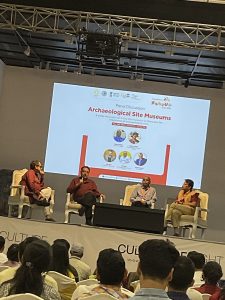Pratiksha Shome
At the museum expo 2023, a panel discussion was organized on the topic of Archeological site museum. The panel was headed by four esteemed panelists, Ritesh Nanda, moderator; Dr. Mani, Former DG National Museum; Vasant Shinde, Deccan College and SK Manjul, ASI. Even though the discussion was on the importance of site museums and why it should be established. Dr.Mani stated that the very first site museum was established in Sarnath in 1910 and the changing face of archeology and history in India after the establishment of Asiatic society. SK Manjul, an archeologist at ASI, provided insights on how situations changed from the time he was digging at Rakhigarhi excavation site. He also added that sites museums can be excellent sources of knowledge garnered from the place itself.

What took the attention of the audience was the announcement of the new museum at Lothal Gujarat, the National Maritime Heritage Complex. This new museum will be considered as the Lothal heritage and its phase one is about to be completed by Jan 2024. Although it is estimated by the panelists that the museum will be completed by 24’, the enormity of the project says otherwise. Phase 1 includes part museum building Complex with 5 five galleries and a naval gallery to be utilised by Indian Navy & Coast Guard and related land development in 35 acres. This phase is being developed under EPC mode at cost of Rs. 774.23 Crore. Phase 1B consists of the remaining museum including balance galleries, Light House, 5D dome theatre, Bagicha Complex and other infrastructure. This phase is proposed to be developed under EPC mode. Similarly, phase 2 will consist of States Pavilion, Lothal City, Maritime Institute including hostel, Eco resorts, Maritime & Naval Theme Park, Climate Change Theme Park, Monument Theme Park and Adventure & Amusement Park. Components under this phase shall be executed under PPP mode.
The project undoubtedly is very ambitious and holds the potential to be one of its kind, the galleries, SK Manjul said, were to be organized in chronological order, representing India from the prehistoric age to post Independence. There will be a total of fourteen galleries, each having its own unique identity and feature to display. For example, the sixth gallery is dedicated to the Indian Navy and its evolution while the seventh gallery will showcase the trade and cultural relations with Southeast Asai and beyond. The NMHC will also be recreating Harappan town to provide the people with a glimpse of the lives in Harappan civilization.
It is estimated by the panelists that this project will be a tourist destination and will attract eyes generating revenues beyond expectations. “A tremendous opportunity for growth is prevailing with this anticipated project,” said archeologist SK Manjul.





